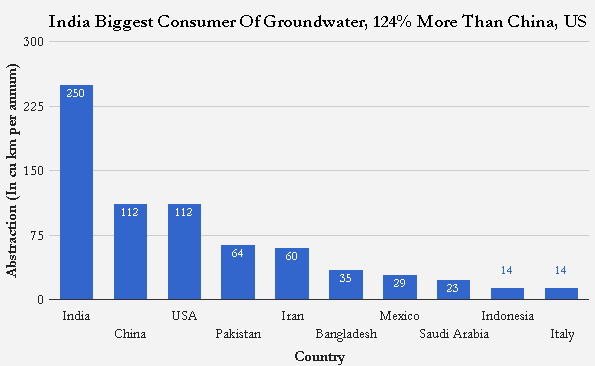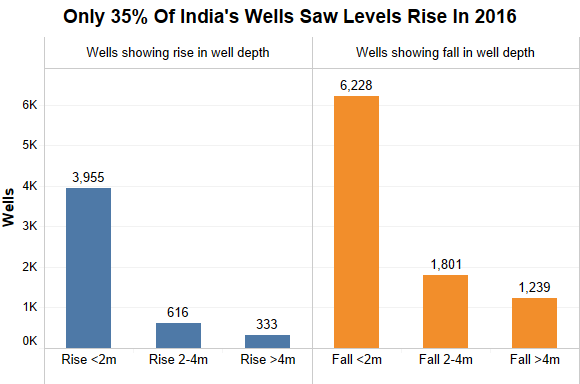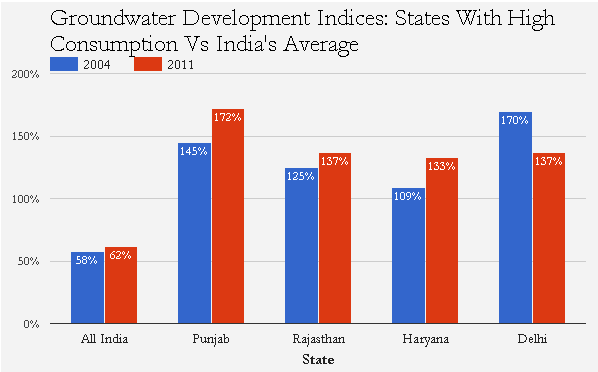A Groundwater Crisis is Threatening to Erupt in India
Published on by Water Network Research, Official research team of The Water Network in Academic
Farmers in Punjab, Rajasthan and Haryana face the prospect of having no groundwater left for irrigation by 2025.

Behind the trend of falling water levels is India’s 251 cubic kilometer annual groundwater extraction rate – equivalent to 26 times the water stored in the Bhakra Dam – making India the world’s biggest consumer of groundwater, according to a 2012 United Nations Educational, Scientific and Cultural Organisation report.
With annual extraction rates of 112 cubic km, China and the US tie at a distant second.
Over nine-tenths of groundwater is extracted for irrigation, according to the Ground Water Year Book for 2014-15 released by the board, underscoring India’s dependence on groundwater for irrigation – it provides water for 60% of the irrigated area, as IndiaSpend reported in October.
Over the last four decades – when India commissioned roughly half of its 50 biggest dams – around 84% of the total addition to the net irrigated area has come from groundwater, according to this July report by a government committee.

A well-recharging project implemented by the Jal Bhagirathi Foundation, a not-for-profit in Jodhpur, enabled Mahaveer Singh, a fruit and vegetable farmer from Thumbo ka Golia, a village in Jalore district in southwest Rajasthan, to switch from growing only castor oil to chillies, vegetables and, of late, Thai apple ber; his income grew by 40% and could increase by 250% if the berries yield the return Singh expects.
“Now my well yields the same water flow even in the summer months,” Singh told IndiaSpend over the phone. “Now the water is sweet, earlier it was salty,” he said, referring to the improved quality of water.
In contrast, the average farmer in Punjab, Rajasthan and Haryana faces the prospect of having no groundwater left for irrigation by 2025.

Exploiting groundwater
The problem – and the advantage – with groundwater is its decentralised access. A licence is all you need to sink a well on owned land and extract water.
Consequently, India has an estimated 30 million groundwater structures, according to the July government report.
In Punjab, Rajasthan and Haryana, groundwater abstraction exceeds the rate at which it is being replenished through rainfall, back flows from irrigation and seepage from canals, other water bodies and conservation structures.
A licence does not prevent groundwater exploitation, and instead breeds corruption within the system, said Rajendra Singh, a water conservationist from Alwar, in Rajasthan.
“We cannot police 30 million groundwater structures through a licence quota-permit raj,” said the July 2016 government report, instead suggesting that groundwater be recognised as a “common pool resource”, which means that it be considered a community resource and not a resource belonging to the owner of the land.
The report also suggested that the government promote “community-driven decentralised water management”.
Read full article at: Scroll
Media
Taxonomy
- Groundwater
- Water Supply
- Water Resource Management
- Irrigation Management
- Water Resources
- Groundwater Resource
- India
1 Comment
-
In India, the allocation of ownership and use rights on groundwater are least understood. In some places, groundwater is linked to land ownership while in others it is viewed as a ‘common property’. The term 'common property' refers to the status of groundwater as a resource to which all overlying landowners generally have access. The term is not intended to reflect the legal status of groundwater as a 'public', 'common' or 'private' resource.
For all practical purposes, groundwater is open access resource until it is abstracted; and it is considered as privatized as soon as it is abstracted by whoever withdraws it first. What should be the structure of rights to be created on groundwater which would be consistent with the efficiency and equity goals?
Can a specific group of farmers of a village prevent others from pumping water from the aquifer under the village land? No, they cannot; this implies that there are no common property rights to groundwater. Can the government prevent farmers from pumping groundwater under their fields? No: this means there are no public rights to groundwater.
On the other hand, a land owner has a right to sink a bore-hole or a well on his land to intercept water percolating underground through his land, and prevent it from going to other man’s property. This implies that groundwater rights are associated with land title and, therefore, groundwater is treated as private property.
Who owns groundwater when it is harnessed and augmented through percolation tank, check dams or even seepage from canals? Because these structures are built with public money, there groundwater recharge cannot be treated as natural percolation and as private property.
WHAT IS REQUIRED NOW? Groundwater demands on land and the consequences of these demands have to be characterized by examining people's adaptive strategies, and the policy implications, treating social and practical decisions ethically.
2 Comment replies
-
Better Groundwater Governance Only Can Ensure Sustained Water Supply
I have pleasure to inform all that I have authored a book entitled "Better Groundwater Governance Only Can Ensure Sustained Water Supply", published by Lambert Academic Publishing, Germany. (ISBN: 978-3-330-32219-6). The book has been released at the price of 49.90 € Euro on permanent links on morebooks.de, amazon.com,
For water security point of view, I request all to give wide publicity about this book, because, I think public (including all stakeholders) by an large has taken water for granted. The book will be also very useful for students and researchers.
Blurb: All countries are confronted with water scarcity of varying types. The daunting biggest challenge for the authorities is in protecting groundwater from depletion and pollution, and making sound managing decisions on complex issues/activities that may affect water supply at local and basin scale. For short-term situation management when water supplies are affected, the managers usually adopt approaches, which involve eliminating immediate, unacceptable impacts on human and the environment, groundwater-use restrictions, regulation, balancing time and resources. However, these may require more research, time, regulations, funding, technology, etc., and be expensive/complex. This book identifies the issues that affect water supply; and makes scientific endeavors to improve all stakeholders’ awareness and understanding of real groundwater problems, and suggests governance approaches by relevant policies, with strong peoples’ participation efforts by behavioral change. The analysis may be especially useful to professionals in water governance and communications for long-term solutions to ensure sustained water supply, reducing costs and implementing water resources protection strategies, for public benefit.
-
Very pertinent point, Sir, in several states of US, harnessing rainwater has been banned just because that rainwater is needed to be infiltrated into everybody's land so that it can emerge in some water body or other by natural distribution. While we are fighting for the right to the scarce quantum of ground water and the scant little in our river systems, it is ironical that rainwater harvesting is still being relegated as one of the obligations the property developer must address, nothing more. Creation of underground buffers at shallow depths for reuse later, can provide an answer to the undue stress we are creating on our water bodies. Communities can hold rainwater under sand bed filters in much cleaner state using Geocellular blocks lined with HDPE to make such tanks with humongous capacity. Shallow storage under engineered soil beds shall allow the rainwater to stay sterile, devoid of the contaminants like Arsenic, Cadmium, Chromates etc that have actually made most of our ground water in the water stressed areas unfit for human consumption. Unlike surface storage in ponds, rainwater harvested in such underground private aquifers shall also stay protected from evaporation losses, dust contamination and algae/ invasive plant infestation.
-